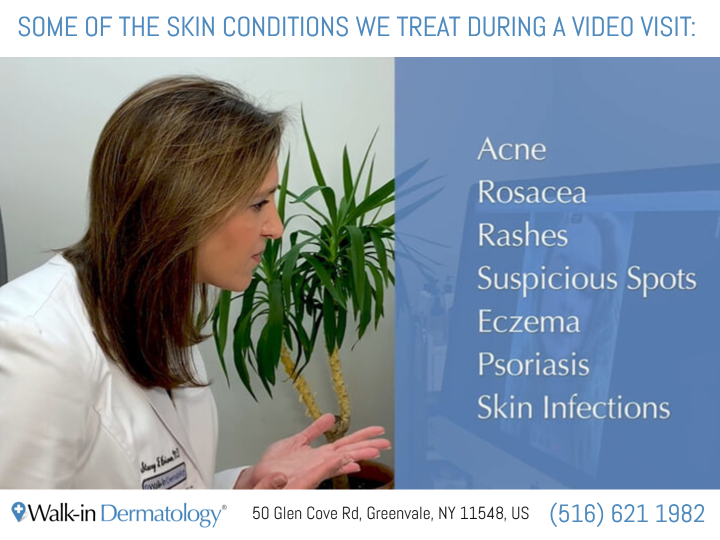Tues: 8:30am - 3:00pm
Wed: 12:00pm - 6:00pm
Thurs: 8:30am - 3:00pm
Fri: Closed
Sat: 8:30am - 12:30pm
Sun: Closed
Greenvale, NY 11548
How Do I Get a Dermatology Referral?


Getting a referral to see a dermatologist is easy when you follow a few simple steps that can speed the process.
If you notice anything unusual on your skin, perhaps discoloration, a fast-growing mole that changes color or shape, or a rash that won’t heal or is beginning to spread, chances are you will best be served by seeing a board-certified dermatologist.
Getting a referral is important because you will probably want your health care insurance to pay for the dermatologist visit – and a referral is usually the first requirement. Check your health plan coverage or call your insurance company to find out precisely what they need to meet the referral requirement.
Most of the time, this will involve a visit to your primary care physician, who’ll examine your skin and attempt to make a preliminary diagnosis. If your doctor cannot treat the problem, you’ll typically be referred to a dermatologist. If your primary care doctor is reluctant to make a referral, don’t let that stand in your way. Studies show that general medical practitioners routinely misdiagnose skin conditions – sometimes with fatal results. Don’t take a chance on your health.
Your primary care physician will send a report of your condition and reason for the referral, plus your medical history, any medications you’re taking and other information for the dermatologist to review in advance of your appointment. This saves you time.
Next, either you or your primary care physician will make an appointment with the dermatologist. This is where things can get tricky. Some dermatology practices may have a wait time of a month or longer. Chances are, your insurance plan will require you to choose a dermatologist who’s “in-network,” meaning the specialist has a business agreement with the insurance company on pricing and scope of services. For instance, cosmetic skin treatments for conditions such as wrinkles may not be covered by insurance.
You’ll also need to find out whether your insurance plan must approve the referral before your scheduled visit. If you call the insurance company, get written confirmation of their response. Finally, before your appointment date, call the dermatologist’s office to confirm your primary care physician has sent over all your necessary medical records.
Although this may seem like a lot of up-front effort, ultimately it will save you time and money.
To maximize your insurance benefits and pay the least out-of-pocket for treatment, you’ll probably need to choose a dermatologist who participates in your plan. But this should not be the only consideration. Experience, credentials and a track record of successful patient outcomes are other important factors to think about when choosing a dermatologist.
You’ll want to see a dermatologist certified by the American Academy of Dermatology. On the specialist’s website, and next to the dermatologist’s name, you’re looking for the designation “FAAD,” meaning Fellow of the American Academy of Dermatology.
If you’ve had lab work done that’s related to your skin condition, bring the results to your dermatology appointment. Also, avoid wearing makeup or nail polish so the dermatologist will be able to examine your skin clearly.
This is the way it’s been done for many years. The problem is, when a patient has an unknown skin condition, waiting a month or more to be seen and treated by a board-certified dermatologist could be a roll of the dice. The skin condition might be easily resolved, or it could be cancerous. Melanoma is a serious skin cancer than can still be treated with a high success rate – if detected early enough.
Waiting a month to find out one way or the other is not good for patients and it’s not good for insurance companies when long delays may result in a worsening condition that requires longer, more expensive treatment.
There is a better way to receive the dermatology care and treatment you need. And it doesn’t involve waiting at all.
At Walk-in Dermatology, patients in the New York metropolitan area and surrounding region can see a licensed dermatologist seven days a week, either by coming directly to the office or scheduling a virtual consultation. With a Video Visit you can see a dermatologist with an online video link and you won’t need to leave the house. No delays. This telemedicine service is especially useful in a time of social distancing.


If you notice something unusual on your skin, early detection and treatment by a board-certified dermatologist could very well save your life. Now there’s no more waiting and worrying for days or even weeks to see a dermatologist. Walk-in Dermatology is open and ready to serve you.
Read more: How Long Do Dermatologist Referrals Take?








